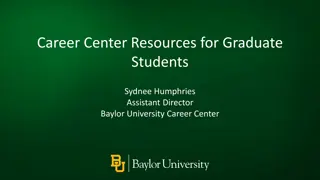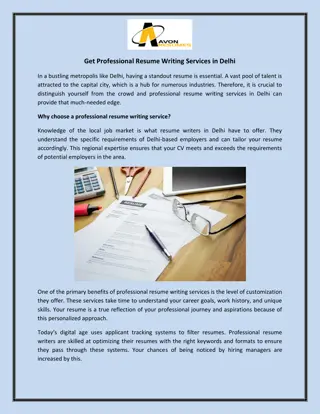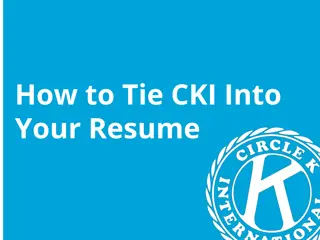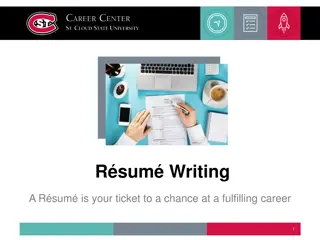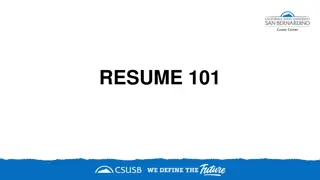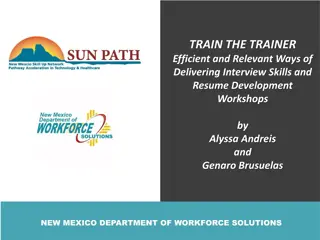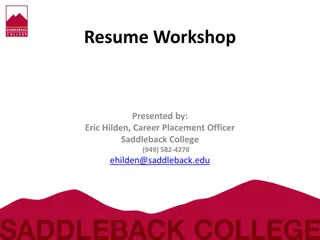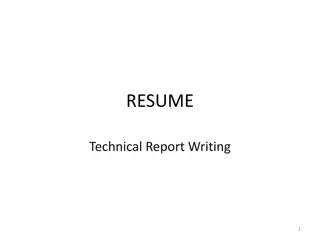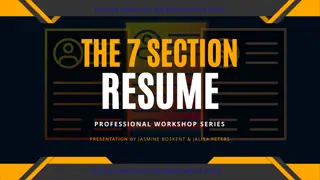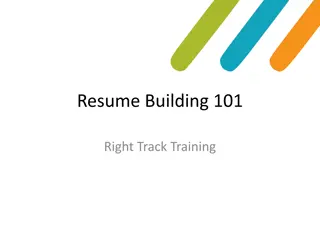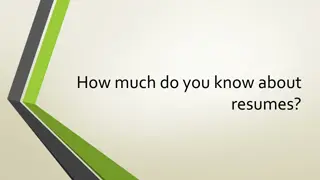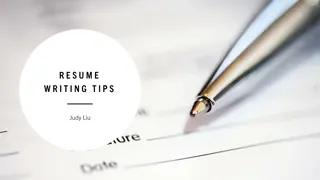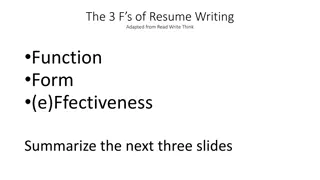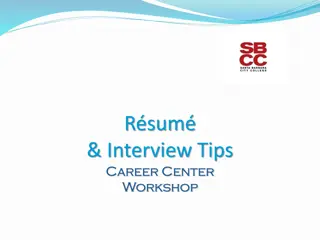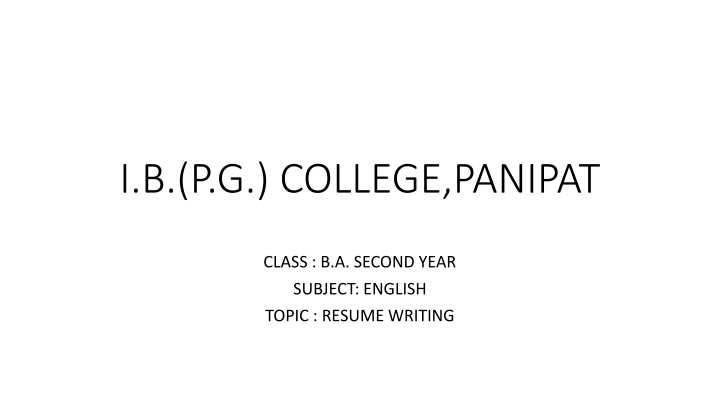
Key Points on Resume Writing for B.A. Second Year English Class at I.B. P.G. College, Panipat
Explore the significance of resume writing in the context of B.A. Second Year English studies at I.B. P.G. College, Panipat. Learn about the essence of a resume, its content elements, and the purpose it serves in securing job interviews. Discover insights on job application letters and tips for crafting them effectively.
Download Presentation

Please find below an Image/Link to download the presentation.
The content on the website is provided AS IS for your information and personal use only. It may not be sold, licensed, or shared on other websites without obtaining consent from the author. If you encounter any issues during the download, it is possible that the publisher has removed the file from their server.
You are allowed to download the files provided on this website for personal or commercial use, subject to the condition that they are used lawfully. All files are the property of their respective owners.
The content on the website is provided AS IS for your information and personal use only. It may not be sold, licensed, or shared on other websites without obtaining consent from the author.
E N D
Presentation Transcript
I.B.(P.G.) COLLEGE,PANIPAT CLASS : B.A. SECOND YEAR SUBJECT: ENGLISH TOPIC : RESUME WRITING
PRESENTED BY PREETI PAL DEPARTMENT OF ENGLISH I.B. P.G. COLLEGE, PANIPAT
MEANING OF A RESUME Simply put, a resume is a one- to two-page document that sums up a job seeker's qualifications for the jobs they're interested in. More than just a formal job application, a resume is a marketing tool that job seekers use to communicate their value to employers
WHAT GOES INTO A RESUME ? A resume summarizes the most important information an employer needs to know when they consider a new hire. The job seeker's relevant qualifications, training, and work history are listed under easily understood resume headings such as "Summary of Qualifications," "Professional Experience," or "Education."
A TYPICAL RESUME WILL INCLUDE THE FOLLOWING: Contact information Job seeker's name, address, phone numbers, and email. Objective or Summary of Qualifications Relevant and impressive qualifications for the desired position, presented at the top of the page, directly under the contact information. Work History Present and/or past employment, including dates, companies, job titles, and relevant skills and accomplishments. Education Highest level of education completed.
WHATS THE PURPOSE OF A RESUME ? The popular belief is that resumes land jobs. Not true. The resume's sole purpose is to land you an interview. If employers like what they see in your resume, they'll contact you to schedule an interview. During the interview, they'll evaluate how well your skills match the job requirements, and how well your personality fits with their team.
JOB APPLICATION A job application letter (also known as a cover letter) is a letter you send with your resume to provide information on your skills and experience. This letter is your chance to sell yourself to an employer, explaining why you are an ideal candidate for a position.
TIPS FOR WRITING A JOB APPLICATION LETTER : Do not copy your resume. Tailor each application letter to the job. Be professional. Carefully proofread. Follow business letter format.
JOB APPLICATION LETTER FORMAT Name Address City, State Zip Code Phone Number Email Address Date Employer Contact Information (if you have it) Name Title Company Address City, State Zip Code Salutation Dear Mr./Ms. Last Name, (leave out if you don't have a contact)
Body of Application Letter The body of your application letter lets the employer know what position you are applying for, why the employer should select you for an interview, and how you will follow up. See below for a paragraph-by-paragraph breakdown of the body of the letter. First Paragraph The first paragraph of your letter should include information on why you are writing. Mention the job you are applying for and where you found the job listing. Include the name of a mutual contact, if you have one. You might conclude by briefly and concisely saying why you think you are an ideal candidate for the job.
Middle Paragraph(s) The next section of your application letter should describe what you have to offer the employer. It can be a single paragraph, or you can break it up into a couple of paragraphs. If the section gets lengthy, you may use bullet points to break up the text. Remember, you are interpreting your resume, not repeating it. Mention specifically how your qualifications match the job you are applying for. In this portion of the letter, make your case for your candidacy.
Final Paragraph Conclude your application letter by thanking the employer for considering you for the position. Include information on how you will follow up. Complimentary Close (examples) Sincerely, Signature (for a hard copy letter) Typed Signature
HOW TO GET YOUR APPLICATION NOTICED ? DON T COPY YOUR RESUME:Your job application letter is a sales pitch. Don t regurgitate your resume; instead, use this document to sell the hiring manager on your skills. TAILOR YOUR APPLICATION LETTER TO THE JOB:Match your skills and qualifications to the job description, highlighting those that make you an ideal candidate. BE PROFESSIONAL:Use business letter format and be sure to proofread your letter before you send.

